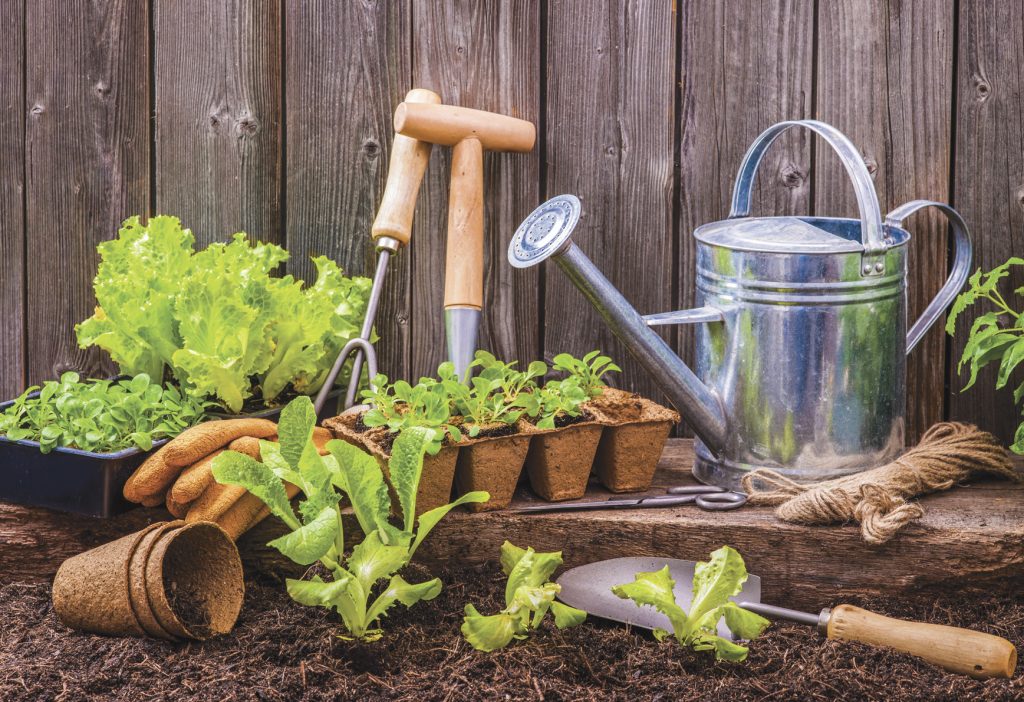When our kids first started gardening, they wanted to grow doughnuts and bluebirds. If only we could, I thought.
Luckily there are many other possibilities for kids, parents, grandparents, teachers, and gardens.
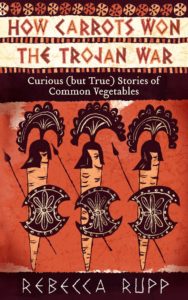
|
How Carrots Won the Trojan War (Storey Publishing, 2011) is an award-winning science and history of garden vegetables. It’s an adult book, but is packed with stories and information adaptable for a wide range of educational and just plain interesting purposes. Find out, for example, about the Burmese Cucumber King, Henry Ford’s carrot obsession, and the pirate who discovered bell peppers, and discover what corn had to do with Dracula and why pumpkins sometimes explode. |
Table of Contents
ABCs and 123s
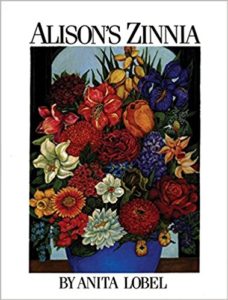 |
Anita Lobel’s Alison’s Zinnia (Greenwillow Books, 1996) is a breathtakingly beautiful alphabet of flowers and girl’s names, from “Alison acquired an amaryllis for Beryl” to “Zena zeroed in on a zinnia for Alison.” For ages 3 and up. |
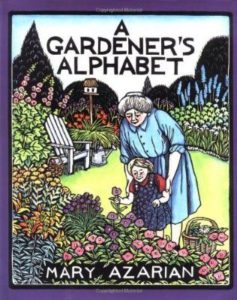 |
Caldecott medalist Mary Azarian’s A Gardener’s Alphabet (Sandpiper, 2005), illustrated with wonderful color-tinted woodblock prints, is a tour of a country garden from ARBOR, BULBS, and COMPOST through QUEEN ANNE’S LACE, TOPIARY, and XERISCAPE. For ages 3 and up. |
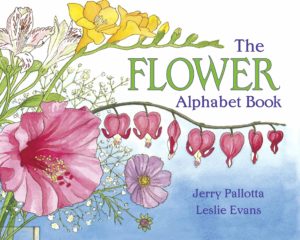 |
From Jerry Pallotta, an indefatigable creator of alphabet books, The Flower Alphabet Book (Charlesbridge Publishing, 1989) covers 26 flowers, each with appealing tidbits of information. For ages 3-8. |
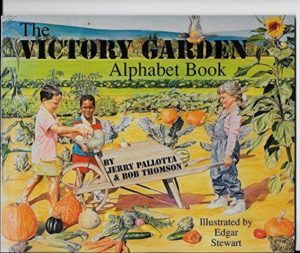
|
Also by Jerry Pallotta, see The Victory Garden Alphabet Book (Charlesbridge Publishing, 1992), written in partnership with former TV Victory Garden host Bob Thomson. An alphabet of veggies for ages 3-8.
And, of course, there’s also Pallotta’s Vegetable Alphabet Book (2016). |
| The Kids Garden Club has instructions for planting an Alphabet Garden, featuring a plant for each letter of the alphabet. | |
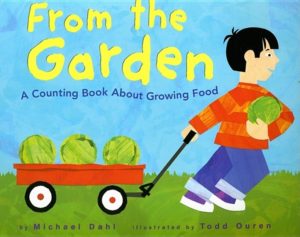
|
Michael Dahl’s From the Garden (Picture Window Books, 2006) teaches the numbers one to twelve as a family picks vegetables from the garden to make a salad. For ages 2-5. |
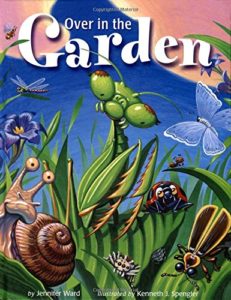
|
Jennifer Ward’s Over in the Garden (Cooper Square Publishing, 2002) is a counting rhyme in the style of “Over in the Meadow,” illustrated with big bright bugs and flowers. (“Over in the garden in the early morning sun/Lived a mother praying mantis and her little mantis ONE.”) For ages 3-6. |
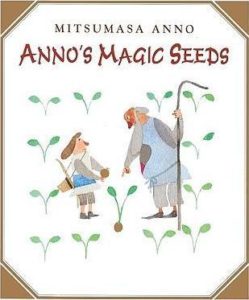
|
In Mitsumasa Anno’s Anno’s Magic Seeds (Puffin, 1999), Jack is given a pair of magic seeds by a wizard, who tells him to eat one and bury the other – which will grow and give him two more seeds in the fall. All goes as planned until Jack decides to plant both seeds, from which he harvests a crop of four. He eats one and plants three, which gives him a crop of six. And so on it goes, as Jack marries, has a son, and plants and harvests more and more seeds. Then a hurricane strikes…Anno brilliantly combines story, art, and geometric progression. For ages 4-9. |
Stories from the Garden
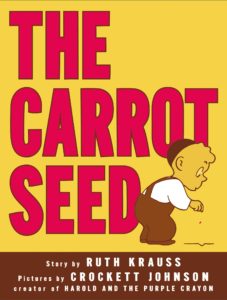
|
In Ruth Krauss’s now-classic The Carrot Seed (HarperCollins, 2004), originally published in 1945, a little boy in overalls plants a carrot seed. Everyone around him is convinced it won’t grow, but he faithfully cares for it anyway – and is finally rewarded with a simply enormous carrot. Faith, hope, and gardening for ages 3 and up. |
| From Teaching Children Philosophy, see a helpful module with discussion questions for The Carrot Seed. (Was the boy right to keep watering his carrot seed? What if they’re in a drought? How do you know when it’s right to stand your ground?) | |
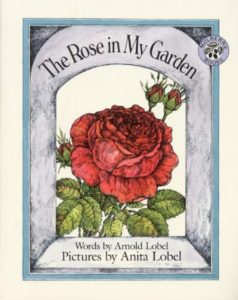
|
Arnold Lobel’s The Rose in My Garden (Perfection Learning, 1993), gorgeously illustrated by Anita Lobel, is a cumulative tale beginning with “This is the rose in my garden.” Then there’s the bee that sleeps on the rose, the hollyhocks that shade the bee, and so on through marigolds, bluebells, lilies, and zinnias – until a terrified mouse bursts upon the scene, pursued by a cat, who wakes the bee. For ages 3-8. |
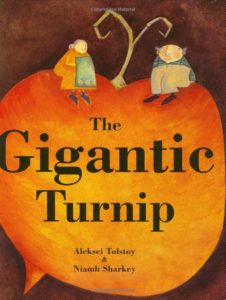
|
Aleksei Tolstoy’s The Gigantic Turnip (Barefoot Books, 2009) is a retelling of the traditional Russian tale in which an old couple plant a turnip which reaches such enormous proportions that it takes the help of all in sight – from cows to pigs to cats, hens, geese, and a mouse – to uproot it. For ages 3-8. |
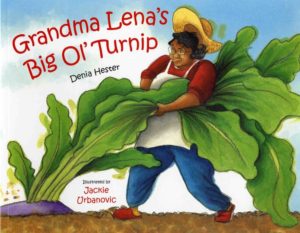
|
For another version of the enormous turnip tale, this one set in Texas, see Denia Lewis Hester’s Grandma Lena’s Big Ol’ Turnip (Albert Whitman and Company, 2005). |
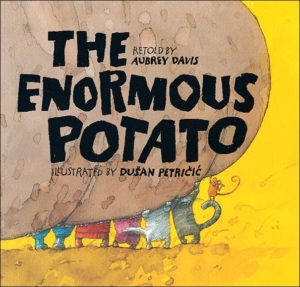
|
Similar giant-vegetable stories include Aubrey Davis’s The Enormous Potato (Kids Can Press, 1999), Jan Peck’s The Giant Carrot (Dial, 1998), and Cherie B. Stihler’s The Giant Cabbage (Sasquatch Books, 2003), this last set in Alaska and featuring a cabbage-planting moose. |
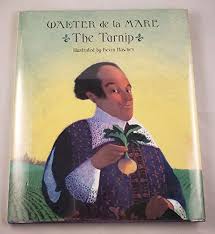
|
Walter de la Mare’s The Turnip (David R. Godine, 2001) is a retelling of a Brothers Grimm comeuppance folktale. A poor kindly farmer grows an enormous turnip and presents it to the king, who gives him a generous reward in return. The farmer’s miserly wealthy brother then brings the king a bigger and better gift, hoping for a more spectacular reward. Instead he gets…the turnip. For ages 5-9. |
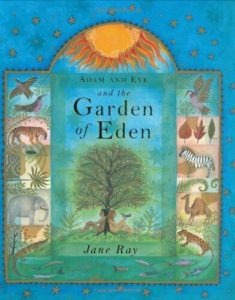
|
Jane Ray’s beautifully illustrated Adam and Eve and the Garden of Eden (Eerdmans Books for Young Readers, 2005) is a picture-book retelling of the Old Testament creation tale, incorporating elements from other cultures – the fountain in the center of the garden, for example, is an Islamic image. For ages 4-8. |
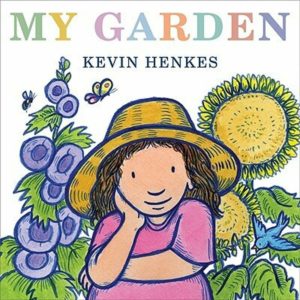
|
Kevin Henkes’s My Garden (Greenwillow Books, 2010) is a marvelous exercise in imagination as a little girl invents her ideal garden, complete with color-changing flowers, chocolate rabbits, sprouting seashells, tomatoes as big as beach balls, and a jelly bean bush. For ages 3-8. |
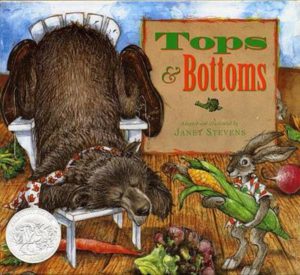
|
Janet Stevens’s Tops & Bottoms (Harcourt Children’s Books, 1995) is a garden-based trickster tale. Since Bear sleeps through every planting season, clever Hare offers a solution: he will plant Bear’s garden for him, and will even split the crops. Bear just has to choose: does he want tops or bottoms? Hapless Bear picks tops – and Hare plants radishes and carrots. Bear picks bottoms – and Hare plants lettuce and celery. For ages 4-8. |
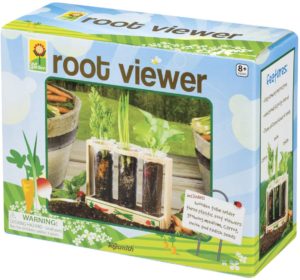
|
A great accompaniment to Tops & Bottoms is a root-viewer garden kit. Generally these consist of a clear-plastic viewer through which kids can watch the roots of their vegetables develop. Also usually included are seed packets, soil wafers, and an informational booklet. |
| Nature Garden Activities for Kids has instructions for making your own root-view box from a half-gallon milk carton. | |
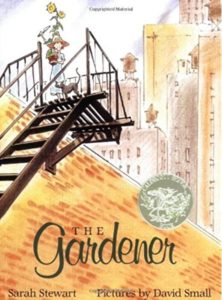
|
In Sarah Stewart’s The Gardener (Square Fish, 2007), set in the days of the Great Depression, young Lydia Grace Finch is sent to the city to live with her Uncle Jim, a dour man who owns a bakery. Plucky Lydia Grace arrives with a suitcase full of seeds, plants a rooftop garden, and wins over her Uncle Jim, who at last begins to smile again. Written in the form of Lydia Grace’s letters to her family back home. For ages 4-8. |
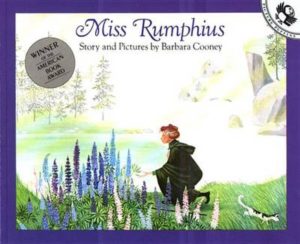
|
The title character of Barbara Cooney’s enchantingly illustrated Miss Rumphius (Puffin, 1985) tours the globe and then comes home to live by the ocean in Maine where she sets out to make the world more beautiful – by planting lupines. A wonderful story for ages 5 and up. |
| From Teaching Children Philosophy, see approaches and discussion questions to accompany Miss Rumphius. | |
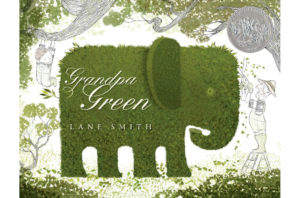
|
Lane Smith’s Grandpa Green (Roaring Brook Press, 2011) is an enchanting picture-book memoir in which a little boy tells the story of his great-grandfather’s life while exploring a marvelous topiary garden. Witty, poignant, and magical. For ages 4 and up. |
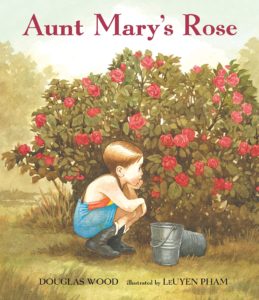
|
Douglas Wood’s Aunt Mary’s Rose (Candlewick, 2010) is the story of how one very special rosebush connects the generations of a family because “if you take care of something, a little bit of you begins to grow inside of it, and a little bit of it grows inside of you.” For ages 5-8. |
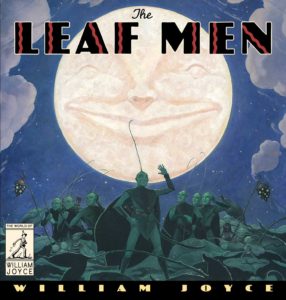
|
In William Joyce’s The Leaf Men (HarperCollins, 2001), an old woman becomes ill and takes to her bed – and her garden becomes sickly too, a victim of the evil Spider Queen and her ant goblins. Having heard the legend of the magical Leaf Men who come to the aid of gardens in peril, the garden’s doodle bugs set out on a dangerous journey to fetch them. For ages 5 and up. |
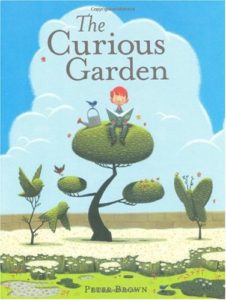
|
Peter Brown’s The Curious Garden (Little, Brown Books for Young Readers, 2009) is an inspirational tale of how small steps can have large and wonderful consequences. Young Liam, who lives in a city devoid of anything green, explores an abandoned railroad track and finds a tiny plot of wildflowers. Determined to save them, Liam becomes a gardener – and by doing so, transforms his world into a green and garden-filled place. For ages 4-9. |
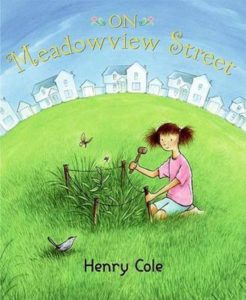
|
Similar in theme is Henry Cole’s On Meadowview Street (Greenwillow Books, 2007), in which Caroline and her family have recently moved to a suburban development where, despite the street name, there’s no meadow in sight. Caroline, however, discovers a single flower and creates a tiny wildflower preserve, which soon expands to encompass more flowers, a tree, a birdfeeder, and a pond. By the end of the book, a barren neighborhood of tract houses has been transformed into a thriving ecosystem. For ages 4-9. |
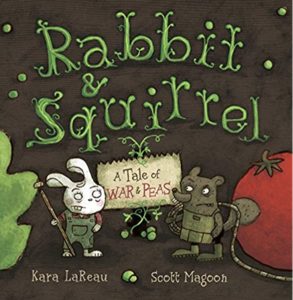
|
Kara LaReau’s Rabbit & Squirrel: A Tale of War and Peas (Harcourt Children’s Books, 2008) features a rabbit (named Rabbit) and a squirrel (named Squirrel) who, though next-door neighbors, are not friends. They do, however, have adjacent gardens – and when their vegetables begin to disappear, each blames the other. Squirrel hurls a rotten tomato at Rabbit; Rabbit turns the hose on Squirrel. Finally a huge human being – to whom, it becomes clear, the garden actually belongs – chases both Rabbit and Squirrel into the woods, where they stubbornly continue their battle. A lesson in how not to cope with conflict, plus vegetables. For ages 4-8. |
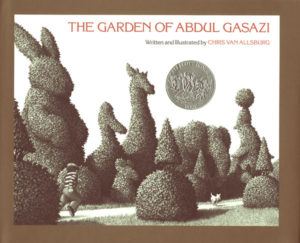
|
The garden in Chris Van Allsburg’s The Garden of Abdul Gasazi (Houghton Mifflin Books for Children, 1979) is an eerie landscape of topiary trees, the property of Abdul Gasazi, a retired magician who hates dogs. Alan Mitz ends up in the garden chasing his obstreperous charge, Miss Hester’s dog Fritz. Before they make their way out again, Fritz is (just possibly) turned into a duck. For ages 5-10. |
| For a lesson plan to accompany The Garden of Abdul Gasazi with a plot summary, discussion questions, and writing projects. | |
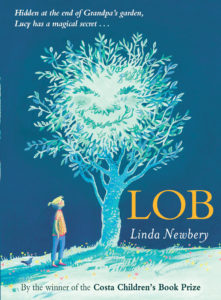
|
Lob, the title character of Linda Newbery’s Lob (David Fickling Books, 2011), is “older than anyone can tell. Older than the trees. Older than anybody.” Based on traditional tales of the Green Man, Lob is the magical creature who lives and helps out in Lucy’s Grandpa Will’s garden, but not everybody can see him. Both Lob and Lucy eventually must cope with the changes that follow the death of Grandpa Will – Lucy struggles to retain her ties with nature and garden magic, and Lob must find a new home. For ages 7-11. |
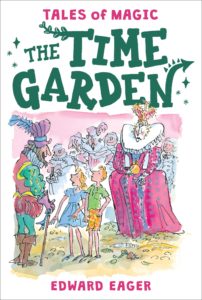
|
In Edward Eager’s The Time Garden (Sandpiper, 1999), four cousins – Roger, Ann, Eliza, and Jack – discover a magical thyme garden presided over by the crusty and magical Natterjack, a toad. The thyme allows the children to time-travel – visiting, for example, the American Revolution (where the pro-British Natterjack causes trouble), the Underground Railroad, the Alcott family, and their own parents as children. The trips are over, however, once the thyme is ripe. For ages 8-12. |
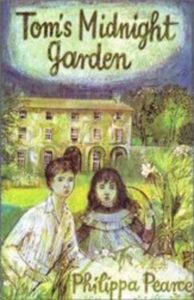
|
In Philippa Pearce’s Tom’s Midnight Garden (Greenwillow Books, 1992), Tom has been sent to live with an aunt and uncle in the city while his brother Peter is recovering from measles. Tom is bored and unhappy in the dreary apartment until one night the grandfather clock in the hall strikes thirteen – and he finds that the back door now opens onto a magnificent garden. There he meets a girl from the past named Hatty with whom he becomes close friends. For ages 8-12. |
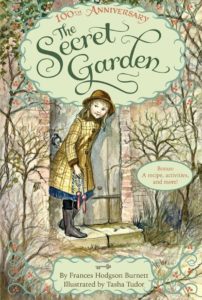
|
The Secret Garden by Frances Hodgson Burnett, originally published in 1911, is now available in many editions. This is the story of ten-year-old Mary Lennox, sent from India to live with her widowed guardian at Misselthwaite Manor in Yorkshire after her parents have died of cholera. Mary, not surprisingly, is miserable, until she discovers a locked and abandoned garden. With the help of Dickon, an animal-charming boy who lives in a cottage on the moor, she begins to bring the garden back to life – and with it, herself and the people around her as well. For ages 9 and up. |
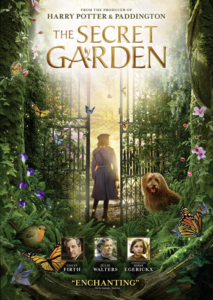 |
In the 1993 move version of The Secret Garden, for reasons known only to the movie-makers, Mary’s neglectful parents die in an earthquake (rated G); the beautiful 2020 version features a truly magical garden (rated PG). |
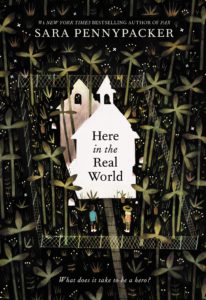 |
In Sara Pennypacker’s Here in the Real World (Balzer + Bray, 2020), Ware – an introverted medieval history buff – has hoped to spend the summer on his own. but his parents insist on sending him to Rec camp to experience Meaningful Social Interactions. Instead Ware escapes to the ruined church across the street where he meets Jolene, determinedly planting a garden, and begins himself to build a version of a castle. The two misfits come together as developers threaten to destroy their world. For ages 9-12. |
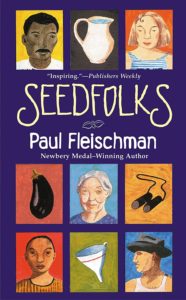 |
Paul Fleischman’s Seedfolks (HarperTrophy, 2004), set in a poverty-stricken urban neighborhood in Cleveland, begins when Kim, a Vietnamese girl, finds a hidden spot behind a rusted refrigerator and plants lima beans. That single simple act has far-reaching implications as – for persons of all ages, nationalities, and circumstances – the garden brings pride, identity, friendship, and hope. A wonderful read for ages 10 and up. |
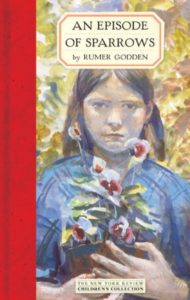
|
In Rumer Godden’s An Episode of Sparrows (NYR Children’s Collection, 2004), is the story of Lovejoy Mason, abandoned by her mother and left in the care of Vincent and Ettie Combie who run a struggling restaurant in London. Lovejoy becomes obsessed with the garden that she has created in the ruins of a bombed-out church, in which endeavor she is helped by a kindly older boy, Tip Malone. The two run afoul of Miss Angela Chesney of the Garden Committee, however, when they begin taking (“stealing,” says Angela) buckets of dirt from the park. Ultimately, however, with the help of Angela’s gentle older sister Olivia, all ends happily, with a number of fulfilled heart’s desires. A truly wonderful book. For ages 10 and up. |
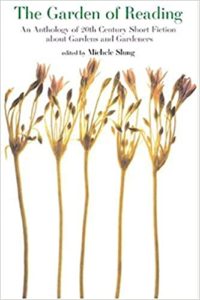
|
Edited by Michele Slung, The Garden of Reading (Overlook/Duckworth, 2005) is an eclectic anthology of short garden pieces by a range of well-known authors. Among the selections: James Thurber’s “See No Weevil,” Eudora Welty’s “A Curtain of Green,” and Stephen King’s “Lawnmower Man.” For teenagers and adults. |
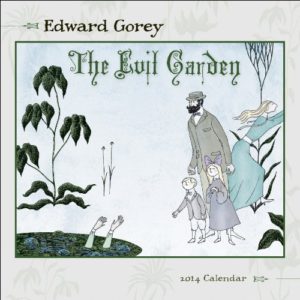
|
Edward Gorey’s The Evil Garden (Pomegranate, 2011) is a wickedly funny exercise in Victorian mayhem as a family enters a garden and is beset by creepy bugs, carnivorous plants, bogs, and bears – all in understated couplets. (“Great-Uncle Franz, beside the lake/Is being strangled by a snake.”) All ages, depending on sense of humor. |
